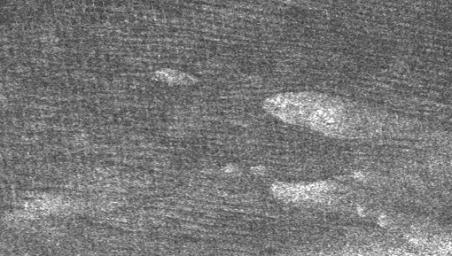
|
Dunes Galore
- Click the image above for a larger view
- Full-Res JPEG (510 x 289) (42.5 kB)
- Full-Res TIFF (510 x 289) (147.8 kB)
Caption:
Large areas of this Cassini synthetic aperture radar image of Titan are covered by long, dark ridges. They resemble the "cat scratches" seen in other places on Titan, but here they are longer and straighter. Spaced about 1 to 2 kilometers (0.6 to 1 miles) apart, they curve slightly around teardrop-shaped bright terrain, giving the impression of a Japanese garden of sand raked around boulders. The bright material appears to be high-standing rough material that the ridges bend around. This suggests that the ridges are dunes that winds have blown across the surface of Titan from left to right (roughly west to east).
This image was taken during the ninth Titan flyby on Oct. 28, 2005, (the fourth flyby for Cassini's synthetic aperture radar), at a distance of about 1300 kilometers (800 miles).
The image covers an area roughly 140 kilometers by 200 kilometers (120 miles). It is located 13 degrees south latitude and 300 degrees west longitude.
Background Info:
The Cassini-Huygens mission is a cooperative project of NASA, the European Space Agency and the Italian Space Agency. The Jet Propulsion Laboratory, a division of the California Institute of Technology in Pasadena, manages the mission for NASA's Science Mission Directorate, Washington, D.C. The Cassini orbiter was designed, developed and assembled at JPL. The radar instrument team is based at JPL, working with team members from the United States and several European countries.
For more information about the Cassini-Huygens mission visit http://saturn.jpl.nasa.gov .
Cataloging Keywords:
| Name | Value | Additional Values |
|---|---|---|
| Target | Titan | |
| System | Saturn | |
| Target Type | Satellite | |
| Mission | Cassini-Huygens | |
| Instrument Host | Cassini Orbiter | |
| Host Type | Orbiter | |
| Instrument | Radar Mapper | |
| Detector | ||
| Extra Keywords | Dune, Grayscale, Radar | |
| Acquisition Date | ||
| Release Date | 2005-11-01 | |
| Date in Caption | 2005-10-28 | |
| Image Credit | NASA/JPL-Caltech/ASI | |
| Source | photojournal.jpl.nasa.gov/catalog/PIA03567 | |
| Identifier | PIA03567 | |
